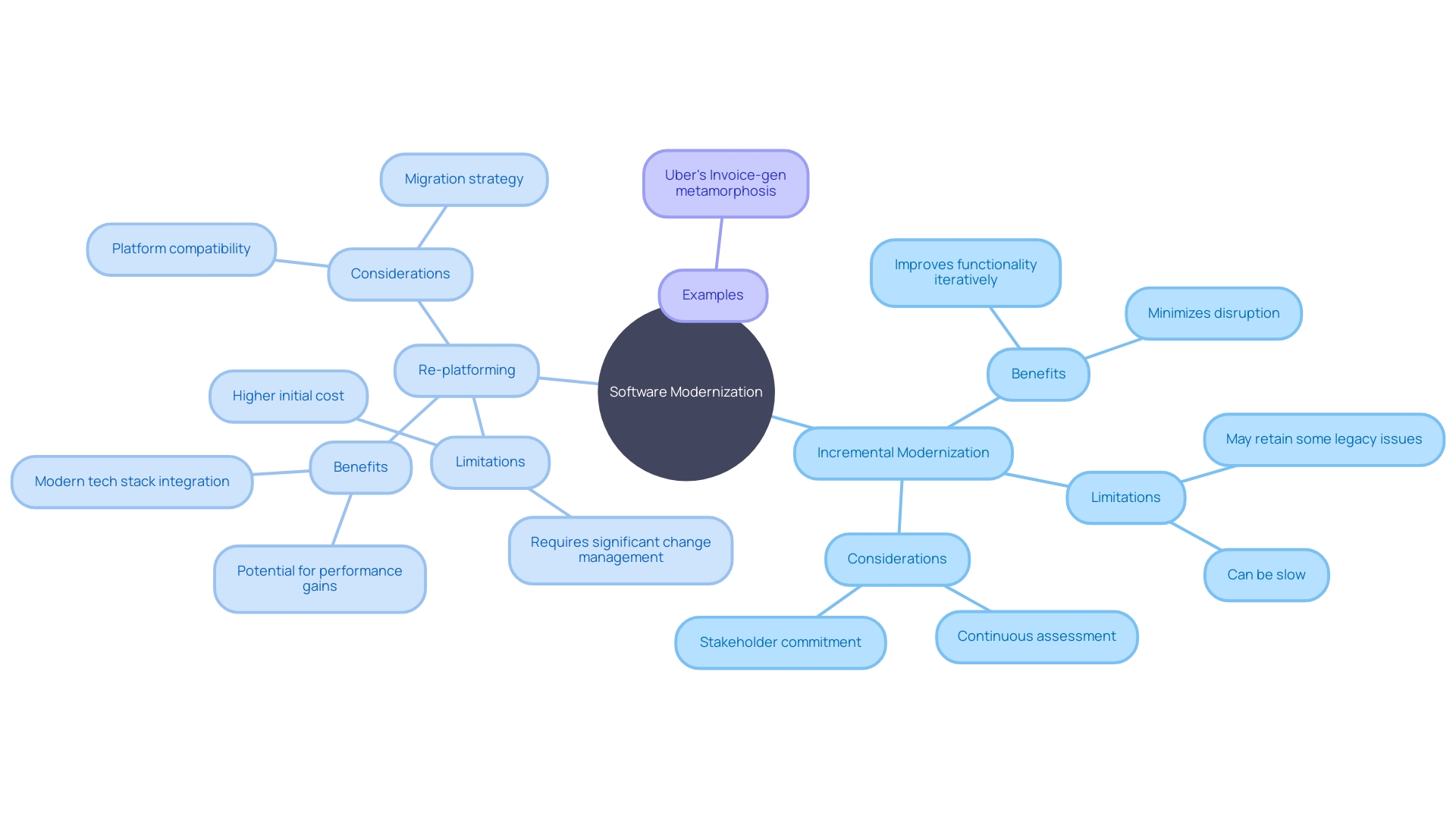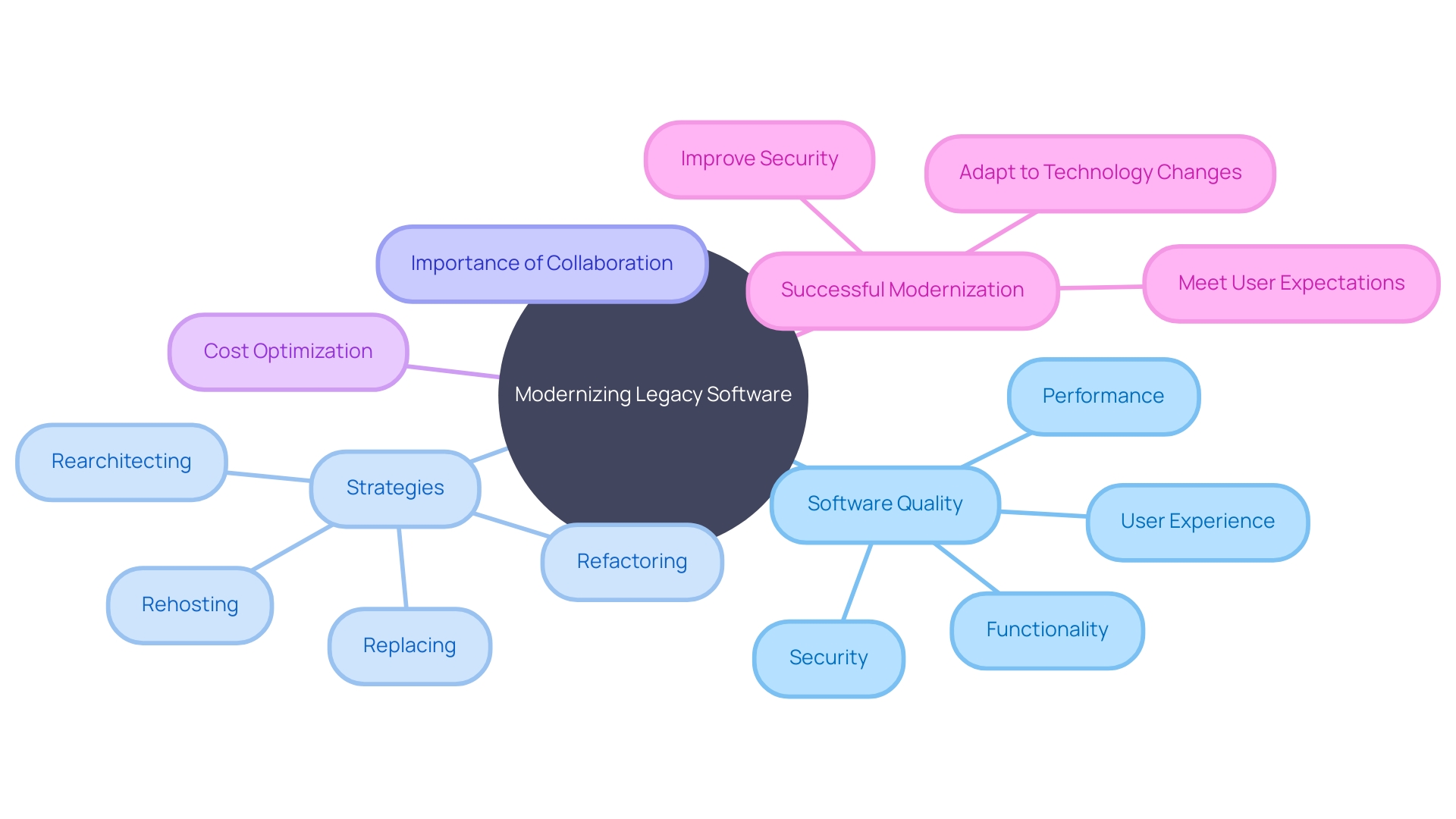Introduction
In today's fast-paced technology landscape, the revitalization of outdated software systems is crucial for businesses to thrive. Referred to as application modernization, this process involves updating, upgrading, or transforming existing software applications to enhance functionality, performance, data security, and user experience. Despite the challenges of investing in a significant overhaul, the long-term benefits of modernization, such as avoiding inefficiency and costly operations, are undeniable.
This article explores the importance of legacy software modernization, the challenges involved, different approaches, and the transformative benefits of successful modernization. It also highlights a case study of a company that achieved retail efficiency through modernization and provides best practices for a successful modernization journey. By embracing modernization, businesses can stay competitive, adaptable, and secure in an ever-advancing digital world.
The Importance of Legacy Software Modernization
Revitalizing outdated software systems is a vital strategy for businesses aiming to thrive in today's fast-paced technology landscape. Referred to as application modernization, this process involves the updating, upgrading, or total transformation of existing software applications to boost functionality, improve performance, secure data, and enhance user experience. The shift towards modernization reflects a desire to keep legacy applications, which can date back decades, aligned with current technological standards, programming languages, and architectures.
It's an effort to combat the drawbacks of aging systems which Arkadiusz Drysch, CTO of Stratoflow, describes with a hint of humor: “Any system deployed in production can be considered legacy... there's no write-and-forget in software development.” This wry observation underscores the continuous need for maintenance to prevent software from becoming obsolete.
Whether through rehosting, refactoring, rearchitecting, or replacing these systems, modernization is tailored to an organization's unique needs and aims to keep them competitive, adaptable, and secure. Despite the daunting prospect of investing in a significant overhaul, reports indicate that Fortune 5000 companies use software that is often over two decades old. The reluctance to update these systems is understandable, given the immediate costs and complexities involved, but the long-term benefits—such as avoiding slow, inefficient, and costly operations—are undeniable.
With the global market for smart home automation predicted to hit $40 billion by 2020, it's clear that outdated systems risk holding businesses back from capitalizing on new opportunities like IoT. Ultimately, the success of such modernization projects is measurable by improvements in operational efficiency, enhanced customer experiences, and an organization's ability to innovate and adapt to a continuously advancing digital world.
Challenges in Legacy Software Modernization
Modernizing legacy software is akin to navigating a complex labyrinth; the aged and intertwined systems often have roots running deep through an organization's operational framework. By nature, legacy systems have accrued customizations, extensions, and a web of interdependencies with other processes that turn modernization into a formidable challenge. Worryingly, many of these systems might operate with scant documentation, complicating efforts by modernization teams to unravel and comprehend original design intentions and functionality.
Moreover, human element—an aversion to change—often materializes as resistance among stakeholders, who may have grown accustomed to the established workflow regardless of its inefficiencies.
To successfully modernize legacy systems, retailers must approach the challenge systematically, weighing factors such as competitive need, technology evolutions, security enhancements, cost optimization, and user expectations. Depending on an organization's unique architecture and legacy underpinnings, modernization strategies may range from rehosting and refactoring to rearchitecting or even outright replacement with more current solutions.
Recognizing legacy software—systems often built on outdated technology and programming practices—requires acknowledging what Arkadiusz Drysch, CTO of Stratoflow, quips about as software’s inevitable transition into legacy status, declaring maintenance as the only constant in a system's lifecycle.
In retail, the pivot away from such legacy systems can unlock transformative benefits. For example, simplifying complex, manually-tweaked systems can mitigate failure risks and infuse innovation into formerly rigid procedures. It can also lead to IT efficiency, establishing an agile foundation that aggregates data for strategic decision-making, like optimizing store locations—a boon for any modern retail enterprise.
Ultimately, the journey of modernizing legacy systems demands a fusion of precise identification of goals and requirements, keen evaluation of software options, and an iterative, detail-heavy approach to rebuilding. Despite the daunting challenges hidden within aging code and infrastructure—akin to stumbling upon unexpected 'easter eggs' in project management—committing to this strategic overhaul is not just about maintaining pace with digital transformations, but significantly enhancing business processes, customer experiences, and, ultimately, securing long-term viability in a rapidly evolving retail landscape.
Modernization Approaches
When embarking on the voyage of software modernization, organizations confront an ocean of choices, each with its unique set of demands, limitations, and benefits. As the sector eyes practices like DevOps, fewer than half of firms have fully embraced such essential methodologies, spotlighting the dire need for better engineering effectiveness, per Forrester Consulting's findings.
A common expedient adopted is incremental modernization, a piecemeal approach allowing gradual supersession or enhancement of legacy components. Its appeal lies in the temperance of risk and disruption intrinsic to extensive system overhaul. On the other end of the spectrum resides re-platforming—a holistic migration expedient guided by the allure of heightened scalability, stellar performance, and adept flexibility.
Uber's metamorphosis of their Invoice-gen service, transitioning from a monolithic Python application to a more modular, maintainable structure, stands as a testament to the efficacy of thoughtfully selected modernization methods.
Yet, it's paramount for the choice of strategy to mirror the organization's vision, available resources, temporal considerations, and coveted outcomes. Here application modernization emerges not only as a technological obligation but also as a strategic foray, ensuring archaic or outdated applications evolve to stay pertinent, robust, and attuned to the incessant rhythm of user and organizational requisites. The journey from legacy to modernized platforms is marked more by necessity than choice, driven by competitive edge and foresight.
To this end, navigating the myriad of approaches demands a discerning blueprint, one that preserves integral knowledge whilst leveraging disruptive technologies to chart a course towards innovation and revitalization.

Case Study: Successful Legacy Modernization
Company X's legacy inventory management system was a stumbling block to its retail efficiency, hindered by outdated technology that struggled with scalability and speed, leading to delays in fulfilling customer orders. The organization grasped the need for transformation and enlisted the expertise of Company Y to modernize its system. This strategic shift to a cloud-based solution provided seamless real-time data integration and advanced analytics for demand forecasting, streamlining their supply chain from suppliers to distribution centers.
As a result, Company X gained invaluable real-time inventory insights, optimizing operational efficiency, trimming costs, and boosting customer satisfaction, ultimately allowing them to thrive in a competitive retail landscape.
Benefits of Modernization
Refreshing older software systems, often tagged as 'legacy systems', triggers a cascade of improvements for businesses. It's like an adrenaline rush to the corporate infrastructure, enhancing agility and robustness to take on more users and complex tasks without breaking a sweat. It counters cyber-threats by patching up those security loopholes that lurk in age-old code.
It's about embracing new tech frontiers, such as AI and machine learning, which can sift through oceans of data for precious business insights. These refurbished systems are nimbler, demanding less time and fewer resources for upkeep, ultimately reducing the strain on budgets and stretching uptime. In essence, the metamorphosis of such systems sets businesses on a fast track, allowing them to pivot swiftly with market shifts and to carve out new avenues for innovation.
Best Practices for Modernization
Modernizing legacy software is not a trivial task; it requires a well-thought-out strategy that encompasses a comprehensive assessment and a clearly outlined change management plan. Windfalls and pitfalls align along this journey, particularly when old paradigms shift to make way for better performance, enhanced functionality, and improved user experiences. Consider the experience of The Ford Foundation, a venerable institution in realizing social change—a legacy CMS that once sufficed for moderate content production was later found inadequate for its heightened publishing demands, signaling the crucial need for modern software.
In this landscape of digital evolution, the modernization process orbits around key dimensions of software quality: Functionality, reliability, and usability remain pillars upon which software's success is built. These are not stagnant targets but dynamic facets that evolve with an organization's roadmap and its user's expectations. Furthermore, effective application modernization involves various strategies such as rehosting, refactoring, rearchitecting, or replacing, chosen based on the unique constraints and requirements of the organization.
Moreover, strategic collaboration emerges as an indispensable element, as seen in the multiprovider, multipartner strategy adopted by Satyendra Kumar's team. With a premium placed on security and data democratization, their experience underscores the importance of collective expertise.
The process also involves a vigilant stance on cost optimization, an area spotlighted by recent proposals from the Financial Accounting Standards Board aiming to modernize how companies report their software costs, reflective of its ubiquitous role across industries.
To encapsulate, successful modernization mandates a seamless blend of assessments, stakeholder synergy, user-centric designs, and a proactive approach to change management. It is here, in the intersection of innovation and practicality, that legacy systems are transformed to meet tomorrow’s challenges.

Conclusion
In conclusion, legacy software modernization is crucial for businesses to thrive in today's technology landscape. By updating and transforming existing software applications, organizations can enhance functionality, performance, data security, and user experience. Despite challenges like resistance to change and complex legacy systems, the long-term benefits are undeniable.
Successful modernization requires a systematic approach, considering factors like competitive needs and user expectations. Incremental modernization and re-platforming are common strategies, with each offering unique benefits. The choice of strategy should align with the organization's vision and available resources.
A real-life case study in the retail industry highlighted how modernizing a legacy inventory management system improved operational efficiency, reduced costs, and enhanced customer satisfaction. This demonstrates the transformative impact of modernization.
Benefits of modernization include improved agility, enhanced cybersecurity, and the ability to leverage emerging technologies. By embracing modernization, businesses can stay competitive and secure in a rapidly evolving digital world.
To ensure successful modernization, organizations should follow best practices such as comprehensive assessments, effective change management, and a focus on software quality. Strategic collaboration and cost optimization are also important considerations.
In summary, modernization is essential for businesses to adapt to digital transformations and enhance their operations. By embracing modernization, organizations can overcome the challenges of legacy systems and achieve significant improvements in performance, security, and adaptability. With the right approach and best practices in place, businesses can thrive in an ever-advancing digital landscape.





